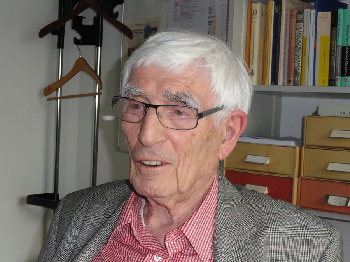
Jack Dunitz, FRS, studied chemistry in Glasgow, and then received research fellowships at the University of Oxford, at Caltech, at the NIH, and the Royal Institution in London, before he became professor of chemical crystallography at the ETH in Zurich in 1957. Since 1990 he has continued his research at the ETH as professor emeritus.
On the wall of his office are pictures of his scientific heroes: David Hume, Dorothy Crowfoot-Hodgkin, Spinoza, Albert Einstein, Max Perutz, and Linus Pauling.
Interview themes:
 Interview with Jack Dunitz.pdf
Interview with Jack Dunitz.pdf
Interview Excerpt
UD: Can we first talk about Gerhard Schmidt and his crystallography and then about yourself and your work? You met Gerhard Schmidt in 1946 in Oxford, where you were a post-doctoral fellow, and he was…
JD: I was already a post-doctoral fellow, and Gerhard was still working on his doctorate though he was older than I, because his scientific studies had been interrupted by the fact that he was arrested with all other German citizens over 18 years old in 1940, sent to the Isle of Man, and then to Australia. Did you know about that? Well I’ll give you my version. He was sent to Australia and thus disappeared from Oxford – he was an undergraduate at the time, and the professor of organic chemistry at Oxford, Sir Robert Robertson, was most upset that they had taken one of his best students away. He kicked up a row about it, and talked to the right people, and so Gerhard was sent back again from this camp, an “enemy aliens” camp as they were called. He came back to Oxford having lost maybe two years, that is why I was ahead of him.
There is a little anecdote which I want to tell you. It started in Oxford and ended about 15 years later in Rehovot: as a student Schmidt is attending a lecture by Sir Robert Robinson and Robinson is talking about organic chemistry and drawing molecules on the board. Now you probably know that carbon is tetravalent, a carbon atom makes 4 bonds. And Robinson wrote by accident 5 bonds in one of his atoms. Schmidt put up his hand. “Yes, yes Schmidt”. “Excuse me Professor, but you have a pentavalent carbon atom on the board.” So Robinson looks at the board, takes a duster, rubs out the offending bond, comes back, glares at Schmidt, and carries on his lecture. Many years later, Schmidt is meanwhile professor at the Weizmann Institute, Robinson has his Nobel Prize, and comes to the Weizmann Institute for some honorary doctorate or similar occasion. He is giving a lecture to a big auditorium. It was still the time of blackboards. Robinson draws a formula, and this time Schmidt, sitting in the front, much more confident now, puts up his hand and says, “excuse me, Sir Robert, but you have a pentavalent carbon… Robinson turns around and says, “Schmidt, you again!?”
Related Interviews: Leslie Leiserowitz